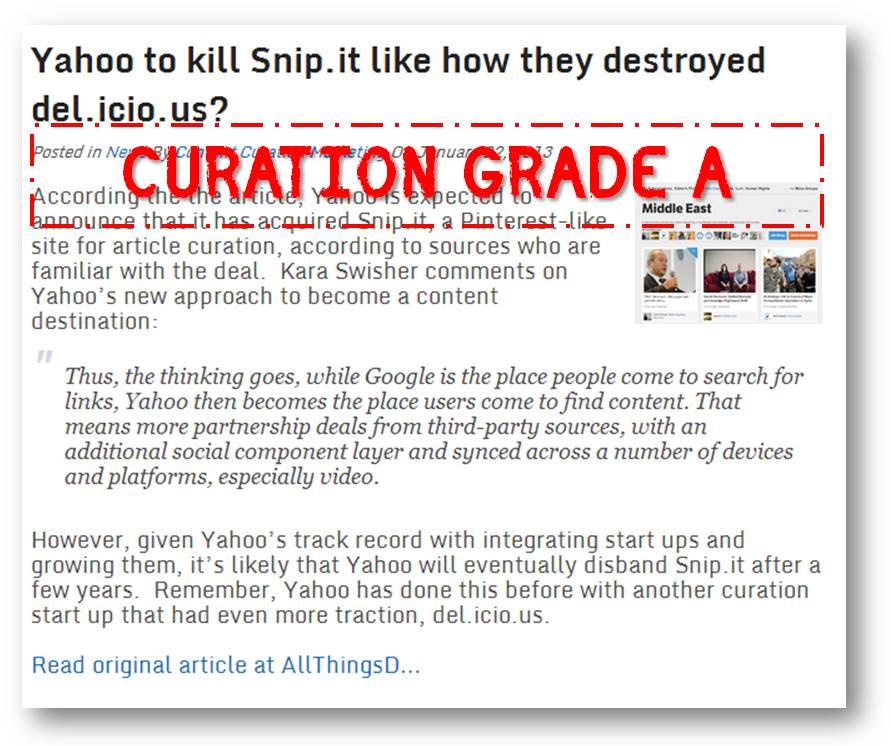Content Curation: Copyright, Ethics & Fair Use
>>Click here to download the eBook.
The most common and fundamental questions that come up whenever I talk about content curation (especially in the context of content marketing) is, “How can you use other people’s content? How does that work with copyright, fair use, and more generally ethics?” This is a topic that I have covered before in earlier blog posts, but since it’s central to curation, it is worth revisiting once again.
Interests of the Three Parties Involved
Before we dive into specific recommendations on best practices, let’s take a look at the interests of the three parties involved when it comes to content curation:
The publisher – the individual, publication or other entity who has created original content. The publisher is usually interested in increased traffic to their site, boosting their search engine ranking, educating their audience, and possibly monetizing their traffic through advertising or subscription revenue.
The curator – The curator is the person or organization who wants to curate the content of the publisher and promote to their audience. The interests of the curator are similar to the publisher but are using curation as part of their marketing strategy. They also want to grow their traffic, search engine rankings, and want to educate their audience.
The audience – Lastly, we have the audience who wants to consume the best and most relevant content in a convenient manner. To the audience, it doesn’t matter if the content comes from the publisher or curator, as long as it is both convenient and useful to them.
Fair-use and curation of other people’s content becomes an issue when it’s not handled properly because the interest of the curator and the publisher overlap significantly. They both want a piece of the same pie: site traffic, increased SEO and visitor retention. When the curation is done wrong, the curator’s interests are served but the publisher sees no benefit. But if it’s done properly, in a symbiotic manner that makes it a win-win, curation can serve the interest of the publisher, and curator, and ultimately the audience.
Fair Use
Here’s what the law says about Fair Use and the four considerations that factor into it:
Section 107 contains a list of the various purposes for which the reproduction of a particular work may be considered fair, such as criticism, comment, news reporting, teaching, scholarship, and research. Section 107 also sets out four factors to be considered in determining whether or not a particular use is fair.
- The purpose and character of the use, including whether such use is of commercial nature or is for nonprofit educational purposes
- The nature of the copyrighted work
- The amount and substantiality of the portion used in relation to the copyrighted work as a whole
- The effect of the use upon the potential market for, or value of, the copyrighted work
The distinction between what is fair use and what is infringement in a particular case will not always be clear or easily defined. There is no specific number of words, lines, or notes that may safely be taken without permission. Acknowledging the source of the copyrighted material does not substitute for obtaining permission.
The key pieces here are that you are not hurting the original author by sharing their work, you are not sharing too much of their work, and that simply acknowledging them as a source may not be sufficient.
12 Best Practices
Kimberley Isbell of the Nieman Journalism Lab cited a Harvard Law report and published an extensive post on the legal considerations surrounding news aggregation. Her summarized best practices and recommendations are below, along with my justifications on why it’s in your best interests as a marketer to follow them as I wrote in an earlier blog post.
Best Practice #1: Reproduce only those portions of the headline or article that are necessary to make your point or to identify the story. Do not reproduce the story in its entirety.
Why you should follow this as a marketer: The more you link to third parties’ original content, the more likely they are to link back to you—which ultimately improves your SEO.
Best Practice #2: Try not to use all, or even the majority, of articles available from a single source. Limit yourself to those articles that are directly relevant to your audience.
Why you should follow this as a marketer: A good content curator is selective and only links to the most relevant content on a specific topic or issue. They do not simply reproduce every article under the sun, otherwise it would be aggregation, not curation.
Best Practice #3: Prominently identify the source of the article.
Why you should follow this as a marketer: Demonstrating that you have curated content from a wide variety of sources, and content from some very reputable sources, makes you more credible as well.
Best Practice #4: Whenever possible, link to the original source of the article.
Why you should follow this as a marketer: Again, linking to the original source may drive traffic away from you momentarily, but makes you more credible for identifying relevant content in other well-known publications.
Best Practice #5: Whenever possible, provide context or commentary for the material you use.
Why you should follow this as a marketer: The more original context you provide, the more of your message you can insert into third party content, and the easier it is for your audience to understand why this content is relevant to them. Furthermore, if your audience values your commentary, they are far more likely to return to you rather than the original sources in the future.
More Best Practices
Aside from those derived from the Harvard Law report, here are some additional best practices I recommend.
Best Practice #6: When sharing images, unless you have explicit permission to share a full-size image, always share a thumbnail image at most.
Why you should follow this: Best Practice #1, of only sharing a portion of any original article, pertains solely to text content. These days people are curating other forms for media, such as images. In the same spirit, you should only share a portion of the original image by using a thumbnail, the same way Google Images does. Apparently the Ninth Circuit United States Court of Appeals decision in the case Kelly v. Arriba Soft Corp ruled that using thumbnail images amounted to fair use.
Best Practice #7: Link back to the original article prominently, not buried all the way down at the end of the post.
Why you should follow this: Best Practice #4 (whenever possible, link to the original source of the article) doesn’t prescribe where that link should be. Some publications, such as the Huffington Post, have received flak for burying links to the original source way at the bottom of a paraphrased article. This discourages readers from visiting the original publisher and does not fairly reward them with traffic.
Best Practice #8: If you are re-posting an excerpt from the original article, make sure your excerpt only represents a small portion of the original article.
Why you should follow this: While Best Practice #1 recommends never to republish an entire original article, there’s still a lot of latitude here to upset a publisher by posting most of their original content. To go a step further, only republish a small portion of the original content at most.
Best Practice #9: If you are reposting an excerpt from an original article, make your commentary longer than the excerpt you are reposting.
Why you should follow this: This is my personal favorite best practice. In conjunction with Best Practice #5 (when possible, provide context or commentary for the material you use), you can ensure you are adding substantial value to content you curate, and simultaneously minimize the amount of original content you re-post, by writing more commentary. It’s also good for SEO because it reduces duplicate content.
Best Practice #10: Retitle any and all content you curate.
Why you should follow this: There are three main benefits to retitling content you curate that are beneficial to both you and the original publisher:
(1) You are no longer competing for the same title on search results. This helps the original source publisher who would be annoyed if your curated version ranks higher than the original version in search engines.
(2) You can add your own spin. It’s fun to retitle content and add your spin to make a title more provocative and appealing. This is particularly important if you are posting curated content on Twitter where your audience can only decide whether to click through based on the title you provide.
(3) Incorporate your own keywords. You can incorporate topic-specific keywords that may not be mentioned in the original article title that are important to you.
Best Practice #11: If you are using a share bar or iFrame, give the reader an option to close the iFrame or Share Bar to view the content without it.
Why you should follow this: Share Bars and iFrames around an original publisher’s content can be annoying to readers. Also, because the browser address bar shows the curator’s URL instead of the publisher’s URL, it can be deceiving. While use of an iFrame is not unethical, to be polite, you should offer readers to ability to close the iFrame and view the original article directly on the publisher’s site. I have written extensively about consideration for using iFrames before.
Best Practice #12: Don’t use no-follows on your links to the original publisher’s content.
Why you should follow this: The no-follow attribute on hyperlinks tells search engines not to give SEO credit to the site you have linked to. This attribute was developed to prevent search engines from crediting spam links left by bots and other nefarious services in user-generated sections of sites such as comment fields. Unfortunately, some curation platforms have employed no-follow attributes on links pointing to the original content publisher’s site. Curators who engage in such practices maliciously withhold SEO credit from the original publisher, while simultaneously using someone else’s work for their own gain.
Examples
In the next section we go over several examples of curation done right, and more importantly, curation done poorly.
The Huffington Post
The Huffington Post, which has gotten a lot of heat (and mockery) for their curation practices, is our first example. Previously the Huffington Post was known for finding a single third-party article, extensively rewriting/paraphrasing the article, and placing a tiny link to the original source at the very end of their rewrite.
They have improved significantly since then in writing articles by stitching together facts and opinions from several different articles, and linking to the articles inline in context, as opposed to at the end of the article. In addition, they are doing several other things right, such as retitling the article.
However, the Huffington Post gets a curation grade of “C” here because the manner in which they link is deceiving. It’s very difficult to discern where the link to the original article is in the text because the link color is nearly the same color as the article itself.
There are only two ways for you to know where the link exists: (1) you make your nose touch the monitor and stare, or (2) you happen to hover your mouse over the link in which case the link gets underlined. Regardless, the Huffington Post is clearly trying to discourage visitors from going to the original source in a deceptive manner. Not cool.
Scoop.it
The next example comes from a page called Upcycled Garden Style curated using the Scoop.it platform. There are a few things done well here. Firstly, there are prominent links to the original source article if you click on on the title, or the image itself. Also, below the image they clearly display the site from where this content was curated.
On the flip side, there are a few things that go against best practices. (1) The image shown is full-size, not a thumbnail, violating best practice #6. Posting full size images through a curation platform like Pinterest could get you in hot water legally. (2) The excerpt of the article is taken verbatim from the original source with the entire instructions on how to create upscale stepping stones. (3) This is borderline scraping of content, and strongly disincentivizes a reader from visiting the original source. (4) If you look behind the code, Scoop.it is using nofollow links, giving no SEO credit to the original content creator. In fact, the Scoop.it platform defaults to certain content reposting techniques that put you at risk—such as full size images and no-follows—unless you seek explicit permission from the original publisher, as per their terms of service:
To the extent you are granted express permission or allowed to do so under applicable law, you must retain all trademark, copyright and other proprietary notices on downloaded and copied Materials, and any such downloads or copies are subject to the terms and conditions of these Terms.
Though there are some best practices being followed here, overall, this example of curation gets a “D” when it comes to best practices.
CMO.com
Adobe runs a great curated content site at CMO.com. You can read more about Adobe’s use case in Curata’s Content Curation Look Book. In this example, they clearly cite the original source (Mobile Marketer), only use a small excerpt, and have a strong call-to-action to drive traffic back to the original publisher.
However, beyond that, they have not added any commentary or value to the curated content except for exposing it to their audience. Therefore, they get a curation grade of “B.”
Content Marketing Institute
The next example is from the Content Marketing Institute. Following a webinar I did with Joe Pulizzi, he posted an article about fair use and content curation. While its intent is good (educating content marketers about ethical content curation), and it clearly cites me as the source of the content, the approach is lacking.
Here, he reposts the majority of my original blog post on this topic (highlighted in black), which disincentivizes readers from viewing my post, because they can get everything they need from his post. It even has my original typos in the re-post! The irony is that a blog post on fair use doesn’t respect fair use itself. This gets a curation grade of “D.”
Slashdot
Slashdot is a site that provides curated “news for nerds.” In this example, a user has taken an excerpt from a fairly technical article, added his own commentary, and clearly linked to the original source. The only thing that could be done better is to provide slightly more commentary that is longer than the excerpt. Slashdot, you get a “B+.”
PexHill
The next example is from PexHill, which found one of my posts on Content Curation & Analytics (shown inline in bottom right). In this case, they liked my content and decided to share it to their audience. They liked it so much in fact, they reposted the entire blog post on their site, including the original images. This gets a curation grade of “F” for outright scraping.
We reached out to PexHill thanking them for appreciating our content, and asked that they include only a small excerpt, but they chose to remove the whole post instead.

Content Curation Marketing
The last example is one from this very site of content curation done right. I came across an AllThingsD article about Yahoo’s rumored acquisition of Snip.it. For this article, I pulled out a short excerpt from the original article explaining the rationale behind the acquisition. Around it, I provided original commentary on the acquisition, with my prediction that Yahoo will kill the company post-acquisition. I also changed the title to something provocative reflecting my point of view. The source is clearly cited, and linked to without no-follows. Lastly, the image from the article is a thumbnail and not shared in full-size. I give myself an “A” here!
The Bottom Line
At the end of the day, the delineation between ethical and unethical curation is not always completely clear. Like many things in life, unethical curation is one of those things where “I know it when I see it.”
If you cannot remember all the above best practices, there’s really one mantra to keep in mind that should guide you in the right direction: Create, curate, but never pirate.
*Disclaimer: I am not a lawyer. This blog post should not be construed as legal advice by any means. Consult with a legal professional rather than reading a blog post if you are looking for legal advice.
For comprehensive information on how to curate content ethically, download our eBook Content Marketing Done Right.
-
Cendrine Marrouat
-
CurataMarketing
-
-
heidicohen
-
CurataMarketing
-
-
Pati Morris
-
Teddy Yunshik Bae
-
catarinavclemente
-
Billion Dollar Mouth Piece
-
Katherine Ortega
-
Guest
-
-
Susan Schaffer
-
Pawan Deshpande
-
-
Mona Ali
-
larry_parba
-
Katherine Ortega
-
Alex Barca
-
Katherine Ortega
-
-
-
Richard Davis
-
Pawan Deshpande
-
-
MW
-
Igor Buyseech
-
Pawan Deshpande
-
-
Pradeep Sharma
-
ahmed omar
-
ahmed omar
-
ahmed omar
-
ahmed omar
-
lamiss
-
naseya10
-
Maman Seo
-
jesus haley
-
profsaid
-
Akash Ranglani
-
MariellaDube
-
ahmed Helayl
-
ahmed Helayl
-
Rashmi Agrawal
-
شركة ركن الشروق
-
نور محمد محمود
-
Matija Zajsek
-
Sunesh Jose
-
Mohamed ali
















